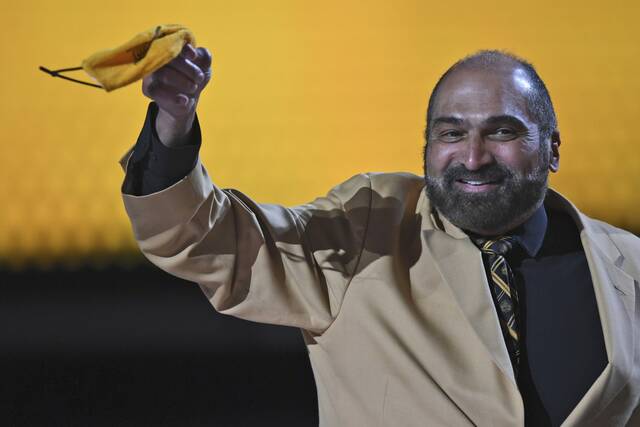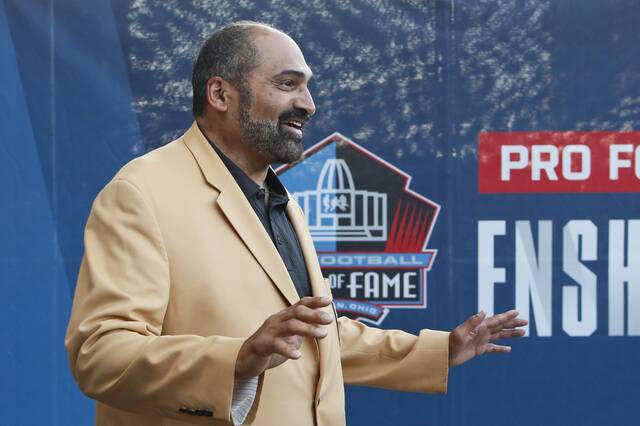Tim Benz: Flowers for Franco
For almost 50 years, it has been easy to link Steelers legend Franco Harris with former Pirates great Willie Stargell.
During the 1970s, they were Western Pennsylvania icons who were largely responsible for turning Pittsburgh into the epicenter of the pro sports world. The prowess of their careers churned along parallel tracks.
In the same city. At the same stadium.
Harris and the Steelers won four Super Bowl titles during that decade. Stargell and the Pirates won two World Series championships and six division crowns.
In retirement, they were often positioned as ambassadors of the city’s sports glory days and forged an inexorable connection between the town and athletics.
When news broke of Harris’ death Wednesday morning, it was impossible to ignore the connection between the legends once more. Stargell died April 9, 2001, in Wilmington, N.C., after complications related to a stroke. That was the day PNC Park hosted its first Major League Baseball regular-season game. It was just two days after a statue of Stargell was unveiled outside the stadium. Stargell was unable to attend the ceremony.
For many in the city, their first view of Stargell’s statue served as much as a memorial for Stargell as it did a celebration of his career.
Similarly, Harris’ death came as the town was gearing up to celebrate his most famous moment. The Steelers, the NFL and the entire city were in the final stages of preparations to commemorate the 50th anniversary of his Immaculate Reception. That was the fabled play in which Harris caught a deflected pass thrown by quarterback Terry Bradshaw and ran it back for a touchdown to help beat the Oakland Raiders in a 1972 playoff game.
The play gave the organization its first postseason win, and it is viewed as the turning point for the franchise from forlorn also-ran into what became an NFL dynasty.
Harris doesn’t have a statue outside the stadium. The Steelers have erected just one of those. It’s in the image of the team’s founding owner, Art Rooney Sr. But Harris does have a statue at the airport, molded to capture the moment of his catch against the Raiders. It’s a fitting announcement to anyone arriving in Pittsburgh for the first time about the priority of sports in this region.
“Welcome to Pittsburgh! Wanna learn about the city? Well, it was founded in 1758. But let’s fast forward to Dec. 23, 1972. We’ll catch you up on the rest later. ...”
The Immaculate Reception itself does have its own plaque outside of Acrisure Stadium where Harris caught the ricocheted Bradshaw pass. And Harris was about to receive a unique honor in Steelers history: the retiring of his No. 32 during Saturday night’s game against the Raiders — the perfect opponent for the league to acknowledge the golden anniversary of one of its most famous moments.
When that happens Saturday, 32 will be just the third number retired by the team (along with Joe Greene’s No. 75 and Ernie Stautner’s No. 70).
Harris’ presence in Pittsburgh was ubiquitous for decades after he stopped playing — through public events, media appearances, team-organized functions, commercials. Because of that, dust never gathered on the videotape of the Immaculate Reception. By extension, nor did it ever gather on the memories of the Steel Curtain and the Super Steelers of the 1970s.
Unlike Stargell’s passing before his statue being unveiled, Harris’ death felt a lot more sudden. Stargell had been battling a kidney disorder for quite some time and hadn’t been in the public eye in Pittsburgh nearly as often as Harris had been. In fact, earlier this month, Harris conducted a radio interview on 93.7 FM. While on the air, he talked about being in good health.
The Steelers held a ribbon cutting ceremony to open their Hall of Honor museum last month at Acrisure Stadium. Harris was involved in the festivities in a way that he so often embraced in the years after he retired — essentially serving as the franchise’s alumni team captain. He was a willing, front-facing touchstone to an era in sports history that is already a half-century old. Symbolically, he was one guy capable of embodying the legacy of the entire roster because of his Hall of Fame career and his part in that one magical moment at the outset of the team’s run of success.
After the tour through the museum, Harris addressed Pittsburgh media members about what it was like living through so much team success in that era.
“During our playing days, we didn’t talk about it, even when we were just around playing poker or having fun. We would never talk about the Immaculate Reception or last year’s Super Bowl. We were just enjoying the moments then. During our playing days, we didn’t reflect a lot on our immediate past. But once we retired, it’s all we talked about,” Harris laughed. “It seemed like it was always … the moment. And what was ahead.”
For years thereafter, Harris adopted the job of being a human conduit to that fabled past.
Team president Art Rooney II in September announced plans to retire Harris’ jersey. At that news conference, Harris said, “It’s like giving you flowers while you’re still around to smell them.”
For five decades, this city has been handing Harris those flowers. His gift, in return, has been to be there so we could be reminded how the garden began to grow.
It just would’ve been nice for him to get one more bouquet Saturday night.
Tim Benz is a Tribune-Review staff writer. You can contact Tim at tbenz@triblive.com or via X. All tweets could be reposted. All emails are subject to publication unless specified otherwise.
Remove the ads from your TribLIVE reading experience but still support the journalists who create the content with TribLIVE Ad-Free.




